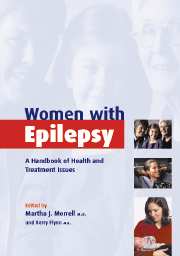Book contents
- Frontmatter
- Contents
- List of contributors
- Part I The woman with epilepsy
- 1 Introduction: why we wrote this book
- 2 On being a woman with epilepsy
- 3 The woman with epilepsy: a historical perspective
- 4 Quality of life issues for women with epilepsy
- Part II Epilepsy diagnosis and treatment
- Part III Hormones and the brain
- Part IV Health challenges for women with epilepsy
- Part V Family planning, pregnancy, and parenting
- Part VI Living well with epilepsy
- Appendix: The Epilepsy Foundation's Campaign for Women's Health: bringing help and hope to women with epilepsy
- Index
- References
4 - Quality of life issues for women with epilepsy
from Part I - The woman with epilepsy
Published online by Cambridge University Press: 02 November 2009
- Frontmatter
- Contents
- List of contributors
- Part I The woman with epilepsy
- 1 Introduction: why we wrote this book
- 2 On being a woman with epilepsy
- 3 The woman with epilepsy: a historical perspective
- 4 Quality of life issues for women with epilepsy
- Part II Epilepsy diagnosis and treatment
- Part III Hormones and the brain
- Part IV Health challenges for women with epilepsy
- Part V Family planning, pregnancy, and parenting
- Part VI Living well with epilepsy
- Appendix: The Epilepsy Foundation's Campaign for Women's Health: bringing help and hope to women with epilepsy
- Index
- References
Summary
Joyce Cramer is a well-known researcher in the fields of epilepsy and psychiatry and holds an appointment at Yale University. Her recent work has focused on the quality of life for people with chronic illness, especially those with epilepsy. She was one of the developers of the Quality of Life in Epilepsy Inventory (QOLIE), which allows people with epilepsy to discuss life concerns by means of a detailed survey. She has challenged the health-care field to consider the well-being of the whole person with epilepsy rather than having a narrow focus on seizure control alone.
In this chapter, Ms Cramer discusses how quality of life may be disrupted by epilepsy and provides suggestions about how to communicate your quality of life concerns to your health-care team. Caring for the whole person works best when the person with epilepsy is an active partner in her care.
MJMWhat is ‘quality of life’?
Health-related quality of life (HRQOL) has been defined by the World Health Organization as a state of complete physical, mental, and social well-being, and not merely the absence of disease or infirmity. It can also be defined as the functional effect of an illness and its consequent therapy on a patient, as perceived by the patient. Within the many aspects of HRQOL, an individual person perceives a problem when there is a difference between actual and desired health status. When the gap between where we are compared to where we would like to be is wide, HRQOL is low.
Keywords
- Type
- Chapter
- Information
- Women with EpilepsyA Handbook of Health and Treatment Issues, pp. 35 - 44Publisher: Cambridge University PressPrint publication year: 2003

